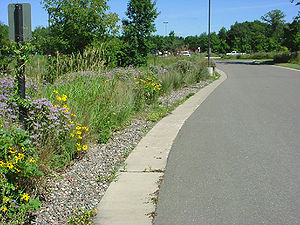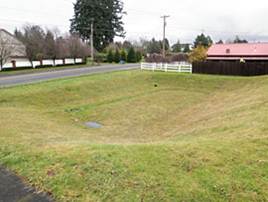
Category:Level 3 - General information, reference, tables, images, and archives/Tables/Infiltration basin, trench, underground infiltration
Infiltration best management practices (bmps) treat urban stormwater runoff as it flows through a filtering media and into underlying soil, where it may eventually percolate into groundwater. The filtering media is typically coarse-textured and may contain organic material, as in the case of bioinfiltration BMPs. These BMPs are sites ranging from small to relatively large. They are primarily designed for removal of stormwater runoff volume and pollutants in that runoff. They are effective at removing total suspended solids (TSS), particulate phosphorus, metals, bacteria, nitrogen, and most organics. Soluble pollutants such as chloride and nitrate typically through these BMPs and into underlying groundwater.
Infiltration practices include several practices, designed to infiltrate water (no underdrain).
- Infiltration basin
- Infiltration trench
- Underground infiltration
- Bioinfiltration
- Permeable pavement
- Swale with check dams
This page (Category) provides links to tables that provide information on infiltration practices.
Pages in category "Level 3 - General information, reference, tables, images, and archives/Tables/Infiltration basin, trench, underground infiltration"
The following 18 pages are in this category, out of 18 total.
I
- Infiltration basin - system construction inspection checklist
- Infiltration guidelines for potential stormwater hotspots
- Infiltration media and material specifications
- Infiltration Summary Table
- Infiltration Trench - Construction inspection checklist
- Infiltration trench/basin – operation and maintenance checklist
S
- Stormwater infiltration BMPs - contributing drainage area
- Stormwater infiltration BMPs - overview
- Stormwater infiltration BMPs - treatment properties
- Stormwater infiltration BMPs – selection considerations
- Summary of Drilling Methods to Collect Soil Samples for Infiltration Basins
- Summary of horizontal and vertical setback distances
- Summary of infiltration practices for given drainage areas
This page was last edited on 4 August 2022, at 18:58.

